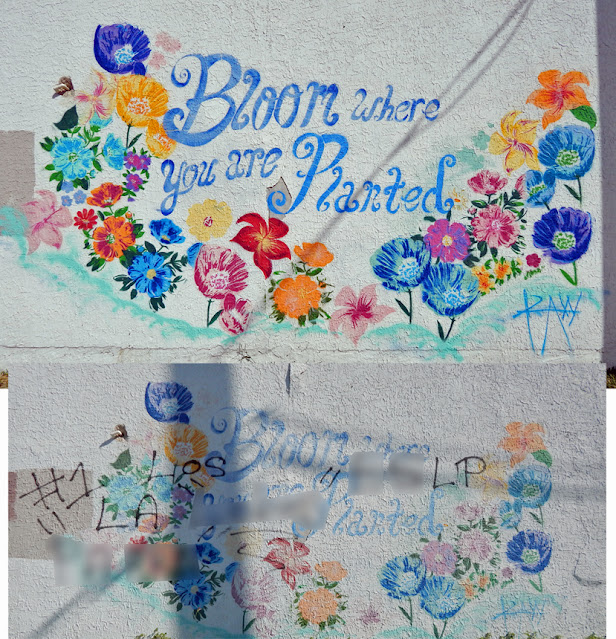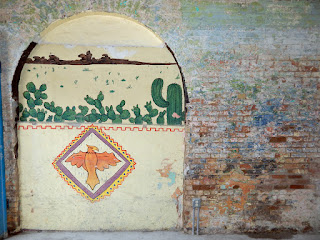This is a continuation of the "1950s Era Murals - or Large Scale Paintings in Brownsville (part 1)" piece we did recently. The main focus is the downtown historic district with a cursory view of locations "discovered" while driving around. If you are a muralist with work in Brownsville please leave a comment to let us know you would like your work added to this blog post.
Wednesday, October 6, 2021
1980s to Present- Murals - or Large Scale Paintings in Brownsville (part 2)
Sunday, October 3, 2021
1919-1953 Coca-Cola Connection
A Pictorial History compiled by Javier Garcia
Recent news coming from local
bloggers is that there seems to be some improprieties in regards to the actions
of our mayor and a city official (who recently resigned) in relation to the
acquisition of property downtown. We’ll
leave that for them to unravel and will focus on the fun aspect of the story –
the history that is!
1912 Peerless Bottling Works photo by Robert Runyon
Since 1886 Coca-Cola had been the fountain drink of choice and its popularity spread all over the United States of America. Our story begins in late 1912 when Robert Runyon took a photo of the Peerless Bottling Works building; “manufacturers of carbonated beverages of quality – bottling Coca-Cola and Jersey Crème” which was at 809 E St Charles St in Brownsville, Texas. George V Ducker was the proprietor of that business.
1919 was the year that Thomas H Sweeney Sr. began his dive into the bottling business but it gets a bit murky here. The following image scrapped from the Brownsville Herald digitized archives shows a seemingly different building than the previous one but the Sanborn maps show a Coca-Cola building at the 809 St Charles address. Brownsville Herald ads include “makers of the best sodas and confections.”
Microfilm image and Sanborn map copy of 1919 Sweeney’s Coca-Cola building. Sweeney started out with four trucks and a team of mules as his “distribution fleet.”
1919 Thomas H Sweeney Coca Cola building. One of the men is probably Thomas Sweeny Sr with Thomas Jr and Peyton F Sweeney. The two boys would be educated in
Lexington, Virginia at the Virginia Military Institute there and later the University
at Austin to return later to the company.
By 1921 the Sweeney’s were at this location, the same building where “Peerless”
was and they a fleet of six delivery vehicles
The building known as "Hanshaw's" on the corner of E Washington and 11th near Market Square is known today as Las Ramblas downtown watering hole and was built by J.G. Fernandez in 1911. (Thanks to our anonymous reader ID'ing it!)
By 1931 the business moved into the Tom Stevenson building on E Adams and 10th
Tom Sweeney and a machine operator in E Adams location.
1939 Brownsville Herald ad shows the E Adams address
By 1931 Thomas Sweeney & Company moved into the building on the corner of 953 E Adams and 10th which we have come to know as the old Tom W “Stevenson Motor Co., Inc.” Chevrolet building because of the Chevy logo frieze that remains visible to this day. Tom Stevenson had been in the business for some time and probably switched over to appliances during the 1930s Depression which sustained him and his family for years to come. He opened up a store on the corner of the Nolan Block building on E Elizabeth and 8th St. This “new” location on E Adams allowed Sweeney to expand with new equipment and space to speed up production and delivery of Coca-Cola beverages. This would be their base of operation for a decade but before we talk about the next location, we have to backtrack a few years to 1927 and the McDavitt brothers.
We’re all familiar with a small stretch of road begins from the Expressway 77/83 near the Buena Vida Cemetery to the point where Port Isabel Road begins and ends when it intersects with Boca Chica Blvd. That road is named after William E. McDavitt who was the pioneer of fruit and vegetable distribution in Brownsville, Texas and came to Brownsville on the second train to arrive here in 1904, the year railroads marked the beginning of a new wave of commerce that attracted people from other states. McDavitt came from Auburn, Kentucky and is credited with shipping the very first carload of vegetables from the Rio Grande Valley. By 1927, he and his brother Karl had partnered with Larry Lightner (another familiar name in Brownsville) to become very successful in the seed and shipping business and wanted a downtown building for offices and rental space. Stanley Bliss of Harlingen (renowned Texas architect) and contractor W.A. Velton built the McDavitt building on E Washington and 10th St where the original Episcopal Church was. The new building would also office Donald Maginnis and Company with the majority of space for Borderland Hardware (Furniture) which had been on E Elizabeth St prior to then. Maginnis & Company were dealers in “cotton futures, stocks, grain and provisions” with offices in New Orleans, Chicago and New York. There is much more to the McDavitt story but if anyone is interested, leave a comment and maybe can read a brief history on them later but at least now you know how McDavitt St got its name and the so-called CocaCola building is really the McDavitt building. It should also be noted that 1927 was a year that many homes and buildings were erected in Brownsville and many were in the Spanish revival style which was popular at the time
1927 full-page ad in Brownsville Herald with clippings from 1920s Borderland ads. Borderland relocated from E Elizabeth St and there were six locations in the Rio Grande Valley at the time
By 1941 the McDavitt brothers had, for whatever reason, approached their years of retirement and the building was sold to Thomas W Sweeney whose Coca-Cola business was not affected by the Depression years or poor crop season and needed more room to operate.
1941 0129 Coca Cola clipping announcing open house event
Merging of newspaper archival record from microfilm and
colorized photograph of 1941 opening of new plant showing a fleet seven
vehicles; some new and some slightly vintage for the time period. Three of the men wearing suits are
undoubtedly Thomas H. Sweeney Sr, Thomas Jr and brother Peyton F. Sweeney. The staff personal working at that building
were A.M. Krebs, Arnold Bassett, Edward A, Covo, Vincent Evans, Federico
Gutierrez, Guadalupe Garcia, Antonio Morales, Rosalie Garcia, William Roy
Pennington, Jack Moser, William Reed, Hubert Rich, Jack Todd, George Garcia,
Pedro Mendez, Filiberto Olivarez, Robert Ford, Mainer Lawson and William S.
Jacques.
In 1941 Brownsville Coca-Cola Bottling Company held an open
house from January 30th to February 2nd from 9 am to 4
pm.
1941 Coca Cola plant interior
The purpose of the new location was designed to expand
production three-fold. There was 100' x 120' work space on the ground floor with a little less on the second. The machinery was enough to supply Cameron
and Willacy counties. Recyclable bottles
were sanitized on one machine before being refilled at the rate of 72 bottles a
minute. Syrup for the bottles came from
a 500 gallon tank on the second floor. The
rest of the second floor was for store rooms and advertisement work shops. Six of the seven trucks were used to deliver
throughout the Rio Grande Valley. The seventh
vehicle was used by the advertisement department.
Coca Cola bottle frieze on the building
1945 salesmen and helpers who deliver the product
1948 Coca Cola
warehouse W Elizabeth before after views
By mid 1948 Mr Sweeney had a new building constructed to
warehouse his bottles by fast freight conveniently next to the railroad tracks on
the 200 block of West Elizabeth St. In a
few years he would expand once again and give control of the company over to his
sons, Peyton and Thomas Jr.
At the start of 1953 it was officially announced that the
Coca Cola Bottling Plant had once again expanded its operations and opened a
brand new 26,000 square foot facility at the corner of Los Ebanos and Woodruff
Ave on a four and a half acre tract of land for future expansion in size for
the future. This new plant could churn
out 150 bottles per minute and had fourteen 55 gallon drums of the syrup used
to pump the bottles full of the refreshing beverage. The rounded roof was
supported by sidewalls with wooden trusses bolted together to support it with
posts which had been manufactured in St Louis and assembled at the new
site. The plant also boasted a capacity
to produce one million cases a year and would serve Cameron, Willacy and Kenedy
counties.
The Sweeney’s once again invited the public to visit the plant for their open house event with the extended invite for schools, church groups, Boy Scout clubs or anyone who wanted to come in and see the operations. Some people might still recall having visited the plant on E Washington or Los Ebanos on a school trip many years ago. I’m sure that would have been exciting to watch as a child. Unfortunately, by the time I saw the inside of that plant it was occupied by a few flea market vendors and one used book seller in the late 1980s. When the actual Coca-Cola plant closed went beyond my willingness to delve any deeper into the history which was mainly aimed at the 1927 McDavitt building and this article has surpassed my initial intent which was to know more about the Coca Cola McDavitt building on E Washington St. Who knows, maybe a in a few years someone can use this information to tell its story for it's hundredth birthday.


















































